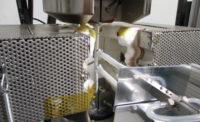Testing Metals and Advanced Materials in Aerospace
Expert testing support provided to the aerospace sector includes developing innovative and bespoke fatigue testing solutions on materials varying from base metal alloys to highly-engineered reinforced composites.






Since the beginning of human aviation history, failures caused by engineering fatigue have been a common cause of structural failures. The first recorded mention of fatigue was in 1837 by Wilhelm Albert who observed fatigue damage in conveyor chains in mines. Five years later, the cause of the fatal Versailles train crash in 1842 was attributed to metal fatigue in a wheel axle. Then, in the 1950s, three de Havilland Comets crashed due to catastrophic decompression after a fatigue crack grew from the corner of a punch riveted square window in the fuselage. All this led to systematic research into metal fatigue and its recognition as a major part of component life.
Engineering fatigue is the repeated application of stress or strain on a component at levels lower than what would normally cause any permanent deformation or failure. Each application and removal of the applied force is called a cycle. Fatigue damage is built up per cycle on a microscopic level within a material, eventually forming short cracks that will lead to failure, and is the most common mechanism for component failure. Fatigue life predictions are calculated through a combination of materials testing and computer modeling and will define critical component inspection and service periods.
Aerospace manufacturers are continually striving to reduce the running costs of their components through reduced weight, improved efficiency or longer service periods, making them more attractive to their market. This can be done by increasingly introducing advanced materials, e.g. composites form 60% in weight of the new Airbus A350, or improved design, e.g. composite wing structures. Fatigue life predictions for new component design or material is required.
Expert testing support provided to the aerospace sector includes developing innovative and bespoke fatigue testing solutions on materials varying from base metal alloys to highly-engineered reinforced composites.
Geometries can vary from small- coupon testing and computer models, to sub-element and full-scale component testing where an entire wing or engine may be subject to applied forces.
For all materials, fatigue sample machining parameters are critical to correctly reproduce surface conditions accurately representing real components and not introduce features that would unrealistically alter the fatigue life. Additional care must be taken when machining composite coupons from components or panels to avoid de-lamination which can have a deleterious effect on fatigue lives. For composites, NDT by ultrasonic method is generally used to assure the absence of any defects or imperfections that may influence the test results.
At some facilities, fatigue testing is generally undertaken on servo-hydraulic or electro-magnetic resonance test frames with load capabilities varying from ±1 kN to ±2.5 MN.
Application of load or strain is controlled through feedback from a transducer in a closed loop system. The transducer could be an actuator mounted LVDT monitoring displacement, a load cell monitoring force or a gage length mounted extensometer monitoring strain. The tolerance of the control channel is ±1% of feedback. The frequency of a test may vary from less than one cycle per second to over 100. However, care must be taken with composites and some metals at high frequencies as internal friction can cause the specimen to heat up and take its temperature outside of the tolerance required for the test.
The pattern of load or strain applied to a specimen, called the waveform, will vary depending on the application, but in general will be sinusoidal, triangular or trapezoidal in shape. The majority of tests will have constant maximum and minimum force or strain, while spectrum varies depending on in-service conditions with turning points based on one of the simpler forms.
The alignment of the specimen is critical as bending strains have been shown to affect fatigue lives. Strain gages mounted on opposite faces of a specimen will allow the calculation of bending strain through their interaction. For fatigue tests, the bending strain must be limited to a maximum of 5%.
Test temperatures range from -80 to over 1,000°C in metals and -80 to 150°C with a different humidity for composites, often requiring pre-soaking for composites or salt water exposure for metals.
Metals are less sensitive to ambient temperature conditions, and lab conditions are typically between 15 and 29°C, but once a test is started, a variance of only ±2°C is allowed. However, composites are much more sensitive and typically require ambient conditions of 23 ±1°C for temperature and 50 ± 10% for humidity. Typically, a number of thermocouples are attached to the specimen and cooling/heating systems are available to manage temperature increases during the test.
Furnaces and environmental chambers can be used for tests other than at ambient laboratory conditions and these are designed to control conditions to tolerances defined in the international standards. Gripping of the specimen will depend on the geometry and can vary from pull bars with threaded adaptors to hydraulic wedge or collet grips, and the gripping arrangement has to be usable at the specific test environmental conditions. For sheet or thin plate type specimens, anti-buckle guides are required for tests that involve compression.
Test durations will depend on applied force/strain, material and test conditions, but could vary from a few hundred to millions of cycles. In real terms, tests can last from seconds to months so long-term stability in test frame control and environment is essential. The point at which the test is stopped can vary from complete rupture of the specimen to load drops relative to a certain strain gage output.
Depending on customer requirements, the following test data can be recorded and reported:
- Loads against cycles
- Actuator displacement against cycles
- Extensometer strains against cycles
- Micro-strains from strain gages against cycles
- Temperature against cycles
- Hysteresis loops – Loading vs actuator displacement, strains, micro-strains, for different cycles
- Maximum and minimum curves for loading, displacements, strains, micro-strains.
Composite materials exhibit complex failure mechanisms under fatigue loading because of the anisotropic characteristics in their strength and stiffness. Fatigue causes extensive damage throughout the specimen volume, leading to failure from general degradation of the material instead of a predominant single crack as with metals. The extent of fatigue damage in composite materials is often characterized by running a defined number of fatigue cycles under specific constant amplitude loading conditions and then testing the residual strength or stiffness. Any decrease in the residual material properties relative to an untested control specimen is attributed to the accumulation of fatigue damage. Post-test analysis of specimen compliance can also be used as an indicator of fatigue damage in composites; as fatigue damage accumulates, the specimen compliance increases and stiffness decreases. This manifests itself as an increase in the displacement of the test frame that is required to reach a test load. NDT methods can be used to intermittently assess the extent of fatigue damage during tests.
There are four basic failure mechanisms in composite materials: matrix cracking, delamination, fiber breakage and interfacial debonding. The different failure modes combined with the inherent anisotropies, complex stress fields, and overall non-linear behavior, severely limit the understanding of composite fatigue behavior. Minor cracks in composite materials may occur suddenly without warning and then propagate rapidly through a specimen. It should be noted that even when cracks have been formed in the resin, composite materials may retain respectable strength properties. Unlike metals, where an impact is usually visible, composites may not have any surface indication one has occurred. These limitations often lead to the adoption of large safety factors which increase weight and cost of composite structures.
To improve efficiencies, engine temperatures and pressures are being pushed to higher levels. New alloy materials and ceramic matrix composites are been introduced and trends in materials testing are shifting to reflect this, creating challenges in that the materials being tested are stronger than the materials being used to grip them. Localized heating solutions such as induction are required to help specimens achieve the high test temperatures, while strain controlled fatigue produce results more closely resembling in-service conditions. Spectrum loading fatigue testing will also be utilized to simulate in-service conditions and increase the accuracy of models.
For composites, the main challenges in materials testing are the development of real time damage monitoring techniques, spectrum testing, controlled wet ageing and representative component testing. Development of a broader database of fatigue properties for commonly used composite systems and layups are areas that need exploration in order to further advance their use in the aerospace industry.
Looking for a reprint of this article?
From high-res PDFs to custom plaques, order your copy today!








